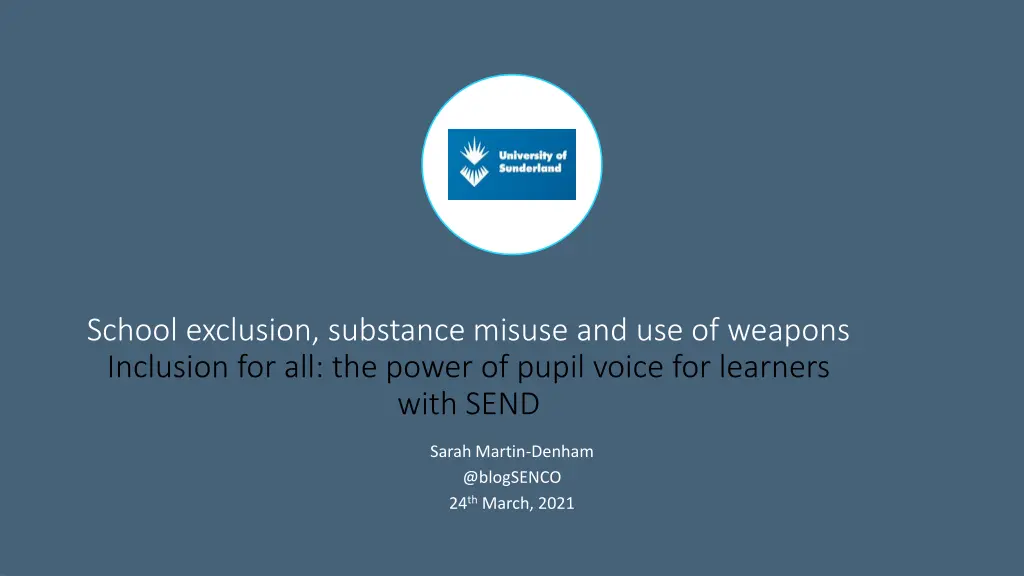
Power of Pupil Voice in Addressing School Exclusion and Substance Misuse
Explore the impact of pupil voice on issues like school exclusion, substance misuse, and weapon use. Discover the findings from primary research on the enablers and barriers to mainstream schooling, shedding light on risk factors influencing drug misuse and carrying weapons to school. Uncover the voices of children, caregivers, and professionals in this comprehensive study.
Download Presentation

Please find below an Image/Link to download the presentation.
The content on the website is provided AS IS for your information and personal use only. It may not be sold, licensed, or shared on other websites without obtaining consent from the author. If you encounter any issues during the download, it is possible that the publisher has removed the file from their server.
You are allowed to download the files provided on this website for personal or commercial use, subject to the condition that they are used lawfully. All files are the property of their respective owners.
The content on the website is provided AS IS for your information and personal use only. It may not be sold, licensed, or shared on other websites without obtaining consent from the author.
E N D
Presentation Transcript
School exclusion, substance misuse and use of weapons Inclusion for all: the power of pupil voice for learners with SEND Sarah Martin-Denham @blogSENCO 24thMarch, 2021
Evidence base (sure.sunderland.ac.uk) 1Martin-Denham, S. (2020a) The enablers and barriers to successful managed moves: The voice of children, caregivers and professionals https://sure.sunderland.ac.uk/id/eprint/11942/ 5Martin-Denham, S. (2020/21) School exclusion, substance misuse and use of weapons: An interpretative phenomenological analysis of interviews with children, 36(2) (In press) Support for Learning. 6Martin-Denham, S. (2020/21) Riding the roller coaster of school exclusion coupled with drug misuse: The lived experience of caregivers. Emotional and Behavioural Difficulties, 25(3-4), pp.244 263. DOI: 10.1080/13632752.2020.1848985 2Martin-Denham, S. (2020b) An investigation into the perceived enablers and barriers to mainstream schooling: The voices of children excluded from school, their caregivers and professionals https://sure.sunderland.ac.uk/id/eprint/11941/ 7Martin-Denham, S. and Donaghue, J. (2020) Out of sight, out of mind? Managed moves in England. Sunderland: University of Sunderland. https://sure.sunderland.ac.uk/id/eprint/11883/ 3Martin-Denham, S. (2020c) A review of school exclusion on the mental health, well-being of children and young people in the City of Sunderland https://sure.sunderland.ac.uk/id/eprint/11940/ 8Martin-Denham, S. and Donaghue, J. (2020) Excluded for no real reason. Sunderland: University of Sunderland. https://sure.sunderland.ac.uk/id/eprint/11472/ 4Martin-Denham, S. and Donaghue, J. (2020) Impact and Measure of Adverse Childhood Experiences, Journal of Public Health https://rdcu.be/b68MO
Exclusions research Sunderland: Funded by Together for Children1,2,3,5,6 In total there were 174 participants interviewed. In addition, there were three advisory groups, 12 children, five professionals from health/support services and five education professionals. This is the most substantial piece of primary research carried out to date on the enablers and barriers to mainstream schooling for those at risk of school exclusion in England.
Martin Martin- -Denham, S. (2021) School exclusion, substance misuse and use of weapons: Denham, S. (2021) School exclusion, substance misuse and use of weapons: An interpretative An interpretative phenomenological phenomenological analysis analysis of of interviews interviews with with children. children. To investigate the risk factors that lead to the children using illegal drugs. To determine the drivers and implications for drug misuse and the carrying of knives into school. The research also hoped to elicit from the young people the solutions that could have prevented their exclusion from school.
Methodology Methodology Mixed methods including content (interpreting and understanding) and interpretative phenomenological analysis (IPA) (Smith and Osborn, 2015). The interviews were suitable for IPA as they included rich detail with novel stories and language (Riley et al., 2017; Spiers et al., 2017; Spiers and Riley, 2019; Smith et al., 2009) . A two-stage process or double hermeneutic was used, where the participant makes sense of their world and the researcher, in an active role, attempts to authentically make sense of their experiences (Colaizzi, 1978; Giorgi, 1985; Smith and Eatough,2007; van Manen, 2014 (Harding, 2019). Theographs were also used to create a timeline of events that led to drug use.
Question with free text answers
The five children Five children Drivers, supply and implications of drug use Drivers and implications of carrying a knife Solutions to reducing fixed- period and permanent exclusion
Click to add text Click to add text
Drivers for drug use Drivers for drug use5,6 5,6
Implications of drug use Implications of drug use
What can be done to reduce drug use in What can be done to reduce drug use in CYP? CYP?
What can be done to reduce drug use in CYP? What can be done to reduce drug use in CYP?
What can be done to reduce drug use in What can be done to reduce drug use in CYP? CYP?
What are the gaps in interventions What are the gaps in interventions and and services? services?
